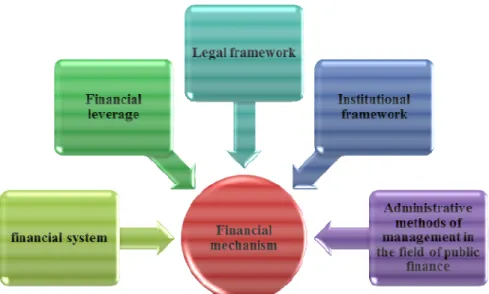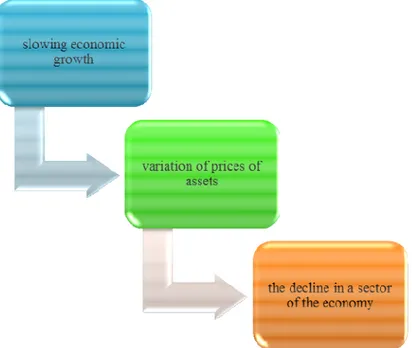Annals of the „Constantin Brâncuşi” University of Târgu Jiu, Economy Series, Special Issue ECO-TREND 2015 – Performance, Competitiveness, Creativity
„ACADEMICA BRÂNCUŞI” PUBLISHER, ISSN 2344 – 3685/ISSN-L 1844 - 7007
THE ROLE OF THE FINANCIAL SYSTEM IN MARKET ECONOMY
C
ş
RUNTU GENU ALEXANDRU
ASSOCIATE PROFESSOR, „CONSTANTIN BRÂNCU
Ş
I” UNIVERSITY OG TÂRGU JIU
cgenuc@gmail.com
CIURL
ş
U LOREDANA
LECTURER PH.D, „CONSTANTIN BRÂNCU
Ş
I” UNIVERSITY OG TÂRGU JIU
lciurlau@yahoo.com
Abstract
Financial system can be approached from the perspective of sales in socio-economic system, namely a global financing mechanism, taking version account specific components, such as: normative base regulatory a financial-monetary methods, forms and techniques version running streams Monetary Financial methods, techniques usable forms and version carrying cash flows, financial levers. Integration contexts, the financial system becomes part of gear intended to ensure implementation and regulation of money flows version compared with the normal performance requirements of real processes in the economy.
Key words: financial system, banks, insurance, financial instrument, financial mechanism
JEL Classification: B26, P34
1.Introduction
Content mechanism differs from one country to another because each economy are its branch structure, specific forms of business organization, institution and supervision regulations, multiple controls and guidelines; apply appropriate management principles and methods; methods and criteria used to quantify various efforts to measure the effects of an efficient and appreciated; use tools stimuli or reducing a course of activities to prevent and combat the phenomena of nature disruptive and imbalanced guidance an activity.
The concept of financial system has several senses arising from different approaches targeted on certain of its constituents. Any economic system using money and run processes and financial relations include financial component, so a financial system.
The approach and defining the financial system most often encountered in the literature is to describe and analyze the ways in which the various components (financial) system are interconnected and mutually-conditioning, both in the context of the systemic and the reciprocal influences of various phenomena and processes.
Synthetic, the financial system is viewed as a system of economic relations, financial funds, financial plans and institutions (Moşteanu, 2004). The expression of the related financial systems domain encompasses a multitude of specific elements linked together by a common essence and phenomena which have relations of interdependence (Philip g., 2002). The financial system is viewed as a whole, representing a whole personality form economic relations, the result of national income distribution, which manifests itself in the complex process of formation, distribution and use of monies-financial (Ştefura g., 2007).
The financial system as a whole, relations must be submitted, with reference to its economic content, as a set of relationships that manifests itself in the complex process of formation, distribution and use of the monies. It is bounded in terms of two components with susbsistem: public financial and subsystem private financial subsystem.
2. Financial mechanism
The mechanism for the operation of the national economy is made up of components that form the financial financial mechanism. The components of the financial mechanism are: financial system, state financial levers for influencing economic activity, administrative leadership methods used in the field of public finance, institutional framework, the legal framework (figure no. 1).
Annals of the „Constantin Brâncuşi” University of Târgu Jiu, Economy Series, Special Issue ECO-TREND 2015 – Performance, Competitiveness, Creativity
„ACADEMICA BRÂNCUŞI” PUBLISHER, ISSN 2344 – 3685/ISSN-L 1844 - 7007 Figure no. 1 ,,The components of the financial mechanism”
The financial system comprises several categories of financial relations that make up all components, subsystems or shackles of the financial system.
Financial relations presents two important traits: are individualized according to:
participants in the process of allocation of monetary resources; the place of incorporation and the destination of the funds; the methods used for creation and distribution of funds.
link to each other forming a system of financial relations characterized by unity in diversity.
In terms of design elements, you can retain the following relevant data as common knowledge of the financial system (Fîrşescu B, 2010):
financial relations system: overview of economic relations in monetary form, most often financial, relationship or financial-monetary;
system for financial institutions: full organizarearea institutions participating in financial relations, the establishment and distribution of funds, as well as the Organization, conduct and control of economic activities;
as a system of funding: overview of monetary resources funding what are economy at various levels and is used in relation to certain destinations;
as a system for financing the economy: overview of funding arrangements within the economy, in addition, most often in the form of financing through capital markets, the indebtedness to banks.
as a system of financial and monetary flows: flows of running the economy, macro-and micro-level, which should be analysed in relation to actual flows, being part of some financial circuits.
Figure no. 2 ,,Common knowledge of the financial system”
Annals of the „Constantin Brâncuşi” University of Târgu Jiu, Economy Series, Special Issue ECO-TREND 2015 – Performance, Competitiveness, Creativity
„ACADEMICA BRÂNCUŞI” PUBLISHER, ISSN 2344 – 3685/ISSN-L 1844 - 7007
3. The banking system-the basic element of the financial system
Financial system, designed as a series of linked financial components the essence of phenomena cast and distinguished relations of interdependence, is often approached in terms of organizational structure, functional content relating to the conduct of financial activities. In this instance, the financial system of a market economy is a system of financial and banking institutions, with civil or financial relations in the organisation participates in the formation, distribution and use of monies, and thus to the elaboration and execution of financial decisions. Ensemble specialized institutions in the financial and banking activity is known under the name of financial-banking apparatus.
The financial and banking system plays an important role in meeting the demands of the economic laws which acts in our society, in achieving the objectives of social and economic functions of the state. This system contributes to high efficiency use of material resources, human and monetary cost of the company, increasing the liability economic entities in rational administration of human and material resources, and increase the rotational speed of production and circulation; also make an active contribution, multiple paths, the organisation and conduct of fair distribution of gross national product, the achievement of consistency between revenue and expenditure, to the realization of a healthy money movement to the balanced development of the national economy branches, to the achievement of social reproduction, the fair location production objectives. Also through is exercising control over the socio-economic development of the country, which lead to the strengthening of the economic and financial discipline in the judiciary, the fight against and the prevention of fiscal evasion
The three main components of the financial system are: banks,
insurance and investment funds.
Clearly, the banking industry is the main component of the financial system in Romania.
Economic impact measures the total impact of the banking sector by generating income and employment and through subsequent multiplier effect on other sectors of the economy.
Because these elements to allow the efficient allocation of resources in the economy need to be known risks upon themselves and the eco-system.
The main risks are:
slowing of economic growth (may cause loss of banks due to difficulties in repaying loans due to falling sales or lowering wages);
variation of prices of assets (may cause financial losses to investors);
the decline in a sector of the economy, but which has monopolized the attention of banks and investors.
Figure no. 3 ,,The risks of the financial system”
Analysis of financial system has the following three major categories of actors: the banking sector,
Annals of the „Constantin Brâncuşi” University of Târgu Jiu, Economy Series, Special Issue ECO-TREND 2015 – Performance, Competitiveness, Creativity
„ACADEMICA BRÂNCUŞI” PUBLISHER, ISSN 2344 – 3685/ISSN-L 1844 - 7007
the financial sector non banking (insurance market, the market for private pensions and non-banking financial institutions),
the capital market.
Financial-banking mechanism encompasses all financial flows, monetary and credit in national economy. In this regard, the financial and banking system of monetary funds establishes that there shall be attached in the national economy, the distribution of correspondence and their ties, their intervention in economic activities so as to ensure monetary and financial balance at both micro-and macroeconomic models.
The mechanism of the economic and financial-banking sector is called upon to provide increased social and economic sficienşei in conditions of balanced development of the national economy and culture. Economic and social efficiency constitutes one of the basic functions of the economical mechanism and banking and finance. Effectiveness should be ensured on each branch, sub-branch, business customer, product and employment. Etonomico-social efficiency is the sole criterion for dynamic linking with stability in the process of continuous adaptation of the economical mechanism and banking and finance.
Under the mechanism of the economic and financial-banking, economic and financial management, self-financing, occupies an important place.
The mechanism of the economic and financial-banking sector must be adapted continuously to the requirements and possibilities of the national economy. Financial-bank economic mechanism should be characterized by relative stability and rigidity.
The effects of the economical mechanism and financial-banking sector will depend on the extent to which it meets the requirements of objective economic and social development of the country, as well as how people act.
4. Conclusions
The essential function of a financial system is to facilitate payments in an economy. The role of the financial system is to provide necessary mechanisms through which financial funds can be transferred between units with surplus and those who want to borrow. Modalities for financing the economy become relevant, specifying that it is possible to choose a specific structure of the financial system to facilitate the attainment of the objectives.
It's all about choice, basically, between predominant funding through financial market, or by means of the loan, which is specific to the banking system (banks and other intermediaries). Such an approach can be subject to the financial system as the economy's financing system.
An essential feature of the system resulting from the use of complex financial instruments and resides in their ability to ease the transfer of resources (transfer) within the system. The financial market has essential functions, like setting, through negotiation, to the value of a financial instrument and trading them. Financial institutions, in the context of the financial system, membership is notable and as financial intermediaries. Their function consists in feeding on account of deficits entities resources obtained from surplus entities.
5. Bibliography
[1]Bistriceanu P., Noşiuni bancare fundamentale, Editura Economica, Bucureşti, 2014; [2]Brezeanu P., finanşele personale în România, Editura CH Beck, Bucureşti, 2012; [3]Dedu V., Bistriceanu G., Gestiune bancară, editura Economica, Bucureşti, 2010;
[4] Mihai I., Piaşa financiară. Componenta fundamentală a pieşei globale, Editura Fundaşia România de Mâine, Bucureşti, 2015;
[5]Moldovan I.A., Sistemul financiar, factor mobilizator sau inhibitor în economia de piaşă?, Editura ASE, Bucureşti, 2012;
[6]Moşteanu T.(coordonator), Finanşe publice, Editura universitară, Bucureşti, 2008;
[7]Prisacaru M., Ursu S., Andries A., Pieşe şi instrumente financiare, Editura Alexandru Ioan Cuza Iaşi, 2009; [8]www.bnro.ro

